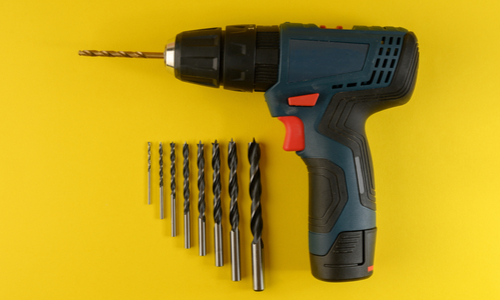Drilling Tools and Their Uses for Your Home

It often happens that homeowners need to hang something up or fix things together. In both cases, to do it, you need to drill holes. However, not every drilling tool is ideal for every type of work. It might look simple, but the world of drilling is vast and exciting. Let’s talk a bit about drilling tools and their uses for homeowners. According to DrillingAdvisor, different power drills can accomplish many DIY jobs in your home.
History of Drilling Tools
Over 37,000 years ago, Homo Sapiens realized what are the benefits of rotary tools. First, it was a sharp rock that, when rotated with hands, drills a hole into another material. Around 10,000 years ago, people used bow drills as the first machine drills. They were used in woodwork and stonework, but also in dentistry and to make fire.
In 221 BC, the Chinese Qin Dynasty invented churn drills, which were used to drill large-diameter holes. In 1885, Isaac Singer built a steam-powered churn drill, based on the method that the Chinese used. However, the greatest advancement in the drilling world was the invention of the electric drill. It was created by Arthur James Arnot and William Blanch in 1889, but the first drill similar to the ones that we have today was patented by Black & Decker.
What Do You Need a Drilling Tool for?
Every homeowner needs a drilling tool at some point. For example, let’s say that you bought a new hanging shelf for the preassembled kitchen cabinet. To mount it on the wall, you will have to drill several holes. Also, if you want to attach two items, you would need to drill holes and insert screws.
Always follow the MEP standards (mechanical, electrical, and plumbing engineering). Make sure to hire an engineer who is fully qualified for any type of project in your home or commercial place.
Also, depending on the type of drill, you can use it to unscrew heavy tightened screws. However, it might be difficult to do with a cordless drill, since their batteries can’t provide enough power for that.
Types of Drilling Tools

As mentioned, there are various types of drilling tools. No matter which tool you use, make sure to always wear protective glasses, gloves, and a dust mask. Of course, you should always use good-quality tools. So, let’s see what are the most common types of drills.
Hand Drill
A hand drill is the simplest form of drill. They are ideal for pre-drilling holes before putting the screws inside. Simply turn the drill left and right until the tip gets in the wood. Then, keep turning the drill to the right until you reach the required depth. These tools are excellent since they require no power and are very easy to use.
Get Expert Solutions for Your MEP Needs!
Hand Drill and Brace
Even though we live in the 21st century, people still use these tools. They are much quieter than electric drills and allow you to make precise holes. You can use them for wood and soft materials, but even in that case, they can’t make deep holes. There are also bits created especially for this type of drilling tool, which allow improved precision.
Standard Electric Drill
These drills are excellent for most fixing jobs. They allow you to fix heavier objects by making holes and using screws. There are two types of electric drills: battery-powered drills, and the ones that are powered by cable.
The first ones are fine because you don’t have to be near the power supply all the time. Also, no cables are getting in your way. On the other hand, the drills powered by cable are usually much more powerful.
Hammer Drill
Hammer drills are similar to standard models but have an additional “hammering” feature. They are great for drilling into tough materials, such as concrete and stone. Many models allow you to switch between hammering and rotating, or even use both at the same time.
Benchtop Drill Press
These units are a bit difficult to use for beginners but can be invaluable to professional DIYs. The main advantage of these drills is that they allow you to make very accurate holes. Besides, they usually produce lots of power and can be used for various materials.
Types of Drilling Bits
Besides drilling tools, choosing the right drilling bit is also of great importance. There are many different types of drilling bits, but let’s mention the ones that homeowners use the most.
Twist Bits
These bits are the most widely used. They are universal and good for most materials, but they are not perfect. Using more specialized bits is always a better option. Also, twist bits are excellent for drilling steel.
Masonry Bits
Masonry bits are easy to recognize since their tip is wider than the body. These are excellent for bricks, stones, and mortar, but you should always use them with a hammering turned on. Otherwise, the tip will wear away pretty soon.
Dowel Bits
These bits always have a sharp tip, and their cutting edges are in the opposite direction. They are ideal for drilling clean and precise holes in wood. However, you can’t use them to drill metal or plastic.
Flat Bits
If you need to drill large holes, where other types of bits are expensive, flat bits are the best solution. They are low cost and low performance and make rough holes in wood.
The only advantage of flat bits is their price. You should choose them if the neatness of the hole is not important, and buying expensive bits is an unnecessary cost.
Augers
These are low-speed, high-torque bits. They are energy efficient and produce very clean holes. Also, you can use them with most cordless drills, if the tool can produce enough torque. However, augers are prone to jamming, so you should always buy a few, just in case.
A Few Words in the End
Choosing the right drilling tool can be complicated if you never used drills before. However, with all the info that we mentioned, choosing the right tool becomes much simpler. You will surely need a drilling tool at some point, so make sure to get the right one, and don’t forget about the importance of the right bits.
Nearby EngineersNew York Engineers has a MEP design track record of 1,000+ projects. Contact us via email (info@ny-engineers.com) or phone, and make sure your building systems meet codes.

Ravindra Ambegaonkar
Ravindra, the Marketing Manager at NY Engineers, holds an MBA from Staffordshire University and has helped us grow as a leading MEP engineering firm in the USA
Join 15,000+ Fellow Architects and Contractors
Get expert engineering tips straight to your inbox. Subscribe to the NY Engineers Blog below.

